Greetings on the equinox. On this day, as the equator is briefly in perfect balance with the sun’s rays, we officially make Probable Futures available to everyone. I am delighted to share what we have been building with you and many more people to come.
I started working on climate change in 2012 because I didn’t know anyone else who did. I was attracted to three kinds of research topics: ones that had to do with the future, ones that didn’t have a price or obvious asset to buy or sell, and ones that didn’t fit into the orthodox categories that both business and academia use to divide up the world. Climate change met all three criteria.
I began in the same way I had approached prior topics: I laid out a research agenda, assembled academic papers and books, and did some googling. I figured it might take a year or two to grasp the issues and discover actionable insights, after which I would move on to something else. Within a few months, I realized that the rest of my life would be centered on climate change work.
My colleagues in finance and economics were mostly tolerant of my efforts to get them to pay attention to the physical world they lived in, but the context of their work was about capital, so other than a resistant group of energy investors, most reacted with either indifference or a vague positive sentiment. It was frustrating, in part, because what I was learning was so interesting—in fact, more interesting than anything else I had ever worked on. It was as if I had acquired a new lens through which to see the world. The climate turned out to be both intuitive and wondrous, and it explained so much about why our lives are the way they are. Moreover, it offered clear, instructive, actionable, and urgent insights about the future. I searched for collaborators, and after a couple of years, I stumbled upon Andrea Wulf’s marvelous book, The Invention of Nature: Alexander von Humboldt’s New World.
The Wikipedia entry for Humboldt starts with this: “Friedrich Wilhelm Heinrich Alexander von Humboldt (14 September 1769–6 May 1859) was a German polymath, geographer, naturalist, explorer, and proponent of Romantic philosophy and science.” This is already quite a sentence, but it is an understatement. I could argue that he was the last true generalist. Humboldt embraced the idea of digging deeply into both science and culture, and to bring his ideas to life, he wrote books and created marvelous maps. Reading about him, I felt less alone. I had found a companion, and I didn’t care that he had been dead for 150 years.
We all “know” more while we each know less
Humboldt was generally curious and eager to share what he learned to help us see our capacity to both understand and destroy our earth. His inquiries transgressed divisions that in modern society are deep and rigid. Science, storytelling, business, poetry, engineering, and music all have their own institutions, credentials, and vocabularies. Within each of these divisions are smaller domains that function as societies unto themselves.
One of the impressive features of The Invention of Nature is how Wulf traces the arc from Humboldt’s youth in the late 18th century—when pursuing knowledge in varied fields was encouraged—to the late 1850s, when boundaries began rising between disciplines. Although use of the word science has been steady in English language books for over 200 years, the term scientist didn’t appear with any regularity until the late 19th century. By the time of Humboldt’s death, the community of scientists was pulling away from other aspects of life and dividing itself into smaller compartments.
While getting my PhD in economics, I worked as a teaching fellow for undergraduate classes. During one lecture on American economics history, I was listening to the esteemed professor as she explained how economic advancement during industrialization was enabled by professional specialization. I had recently learned this idea in mathematical form in a graduate course, but somehow, sitting at the back of this room full of young students, the professor’s words startled me. My hand shot into the air involuntarily, alarming her. She paused and pointed at me, clearly unsure why I would be interrupting. “Does this mean that in an advanced society there is no place for generalists?” I asked. “Exactly,” she replied with a winking smile of relief, signaling that she was pleased by what she read as a clever assist to set up her conclusion for the students. Her one-word answer knocked the wind out of me. Humboldt, who fought these separations valiantly, helped put some of that air back in my lungs.
Poetry, precipitation, and atmospheric pressure
Humboldt was born into an elite, wealthy family and was tutored in language, history, literature, and philosophy along with mathematics and science. He was interested in all of those subjects, but he had a passion for the physical world of rocks, trees, animals, weather, and everything else he could take in with his senses. Today, the wealthy elite counsel their children to choose one path in order to be professionally successful. As they reach the end of their formal education, modern society pushes young, highly educated people steadily toward business, finance, and technology. Humboldt, however, stayed in the company of creative people while working in mines and conducting scientific research. His close friendships with poets, playwrights, and novelists led Humboldt to ask different questions than other explorers did and helped him approach new topics and new people with an open mind.
Humboldt’s interest in the physical world was a pursuit of beauty, truth, and meaning. He brought thermometers and barometers everywhere he went. He then recorded not just what he saw and what his instruments indicated, but what his experiences felt like, reminded him of, and revealed to him. He then wrote, drew, and painted what he learned for the growing scientific community, the lay public, and the poets.
Humboldt’s efforts to convey ideas, observations, and meaning succeeded in reaching diverse audiences. He wasn’t just inspired by poets, they were inspired by him.
Henry David Thoreau was a young man trying to understand the world around him and how to live in it as the forests near his Concord, Massachusetts, home were being felled to build and fuel industry. He was interested in science, observation, and poetry and afraid of failing to connect them. “Every poet has trembled on the verge of science,” he wrote. Reading Humboldt helped him overcome his fear. He stopped using one journal for “poetry” and another for “facts.” Thoreau’s Walden then inspired more people to pay attention to the rapidly diminishing natural world around them and find companionship in the beautiful and mundane among plants, animals, and weather. Scientists also used Thoreau’s well-written facts for generations to come.
The forced professional narrowing of advanced economies has increased the scope and power of humans, just as the professor said it would. It has also enabled a tragedy. At a time when we desperately need to understand the world in which we live, the people who make movies, write novels, and compose poetry are separated from the scientific community; scientists are mostly talking to themselves, usually in narrow, specific domains; and the people in business, finance, and government are not in much conversation with either.
Climate change threatens everything, yet frighteningly few people are working on it. I recently spoke with a young man whose company is trying to fund businesses that might reduce the amount of carbon in the atmosphere. “I know all of these people whose ambition is to start some kind of business. If we had better stories about climate change, they might channel their ambitions in that direction,” he told me. Without better stories and more cross-pollination of ideas, however, they keep starting finance and technology companies.
The climate can be seen by everyone, from everywhere
Humboldt’s most famous voyage was to South America, where he found nature in a variety and intensity that his native Europe no longer had. He measured and drew. He also listened and asked, learning that the native people in the regions he visited were sophisticated, aware, and insightful, and that they were being horribly oppressed by European occupiers. Among the strongest observations Humboldt made in South America were that similar climates existed in dissimilar places and that even the most exotic plants and animals had counterparts in other parts of the world.
Humboldt spent much of his young adulthood in the German town of Jena. While climbing Chimborazo, the enormous volcanic mountain in Ecuador, Humboldt looked down and saw how each elevation had different plant life, and how these plants at different heights reminded him of plants in Jena or the German Alps. His detailed observations allowed him to see and marvel at the intricacy and wonder around him. He realized that all of the living and non-living things interacted with and influenced one another. This was a dynamic system. Here is a drawing he made after he and his companions descended:
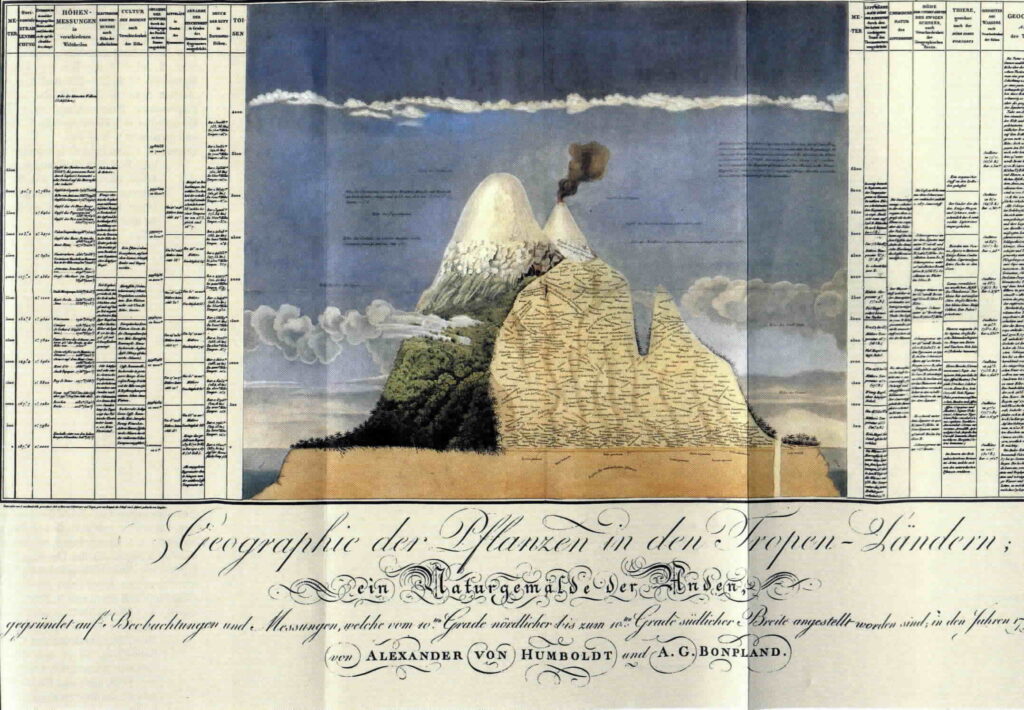
The words written on the mountain are all things he observed, in the locations where he saw them. In the shapes of the text, you can see ridges, contours, and paths. In the columns on the sides are details. The drawing is not just accurate and informative; it is also human and beautiful. It is surely slightly imprecise, but it communicates how much is happening on that mountain. This picture wasn’t just a scientific document. It was a fold-out map in the book he and his collaborator Aimé Bonpland wrote, Essays on the Geography of Plants, which was read by all kinds of people around the world.
Encouraging connections
The separation of science and scientists from the rest of society that came after Humboldt must be bridged. Lay people have had to trust scientists to communicate with them. Scientists have had to guess what and how to communicate. Yet neither group has found good ways to close this gap. This is the ambition of Probable Futures: to provide an entry point, a bridge, and a set of tools that will allow everyone, everywhere, to understand our climate and ask questions about how we are going to address the risks we face.
Humboldt’s books reached all kinds of people because he encouraged them to read them the way we read books for pleasure—to step into the world of the book and bring along one’s senses and experiences. And what they couldn’t experience, they could imagine. This passage from Wulf’s book could be on the Probable Futures website:
“Memories and emotional responses, Humboldt realized, would always form part of man’s experience and understanding of nature. ‘Imagination is like a balm of miraculous healing properties,’ he said.”
People can’t experience the world without memories, stories, emotion, and imagination. Using those abundant resources, we can appreciate and even feel distant people and places without undertaking expensive voyages. Humboldt was delighted to discover that while the exotic sights of South America added to his understanding of the world, they also revealed that much of nature could be appreciated wherever people lived. That is a central goal of Probable Futures.
Uncanny maps
In observing the local, he started to understand the global. Humboldt went on to produce other graphics to help people understand the world, including this one in 1823:
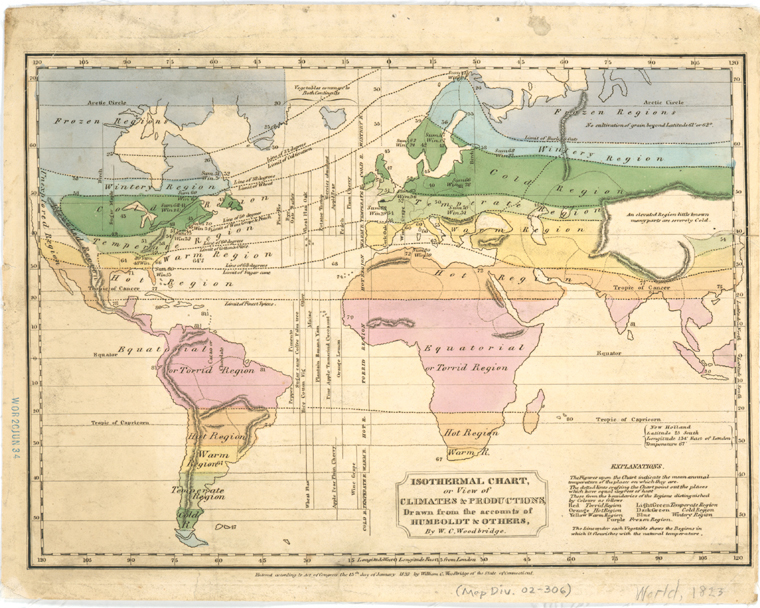
It is a map of temperature. Areas that have the same range of temperatures are in the same colors. He calls the pink central swath the “Torrid Region,” the pale green the “Temperate Region,” and the gray section at the top of the map the “Frozen Region.” The similarity between this map and the ones you will find on Probable Futures is uncanny.
Here is a map of average temperature around the world at 0.5°C warmer than the atmosphere was during Humboldt’s pre-industrial era:
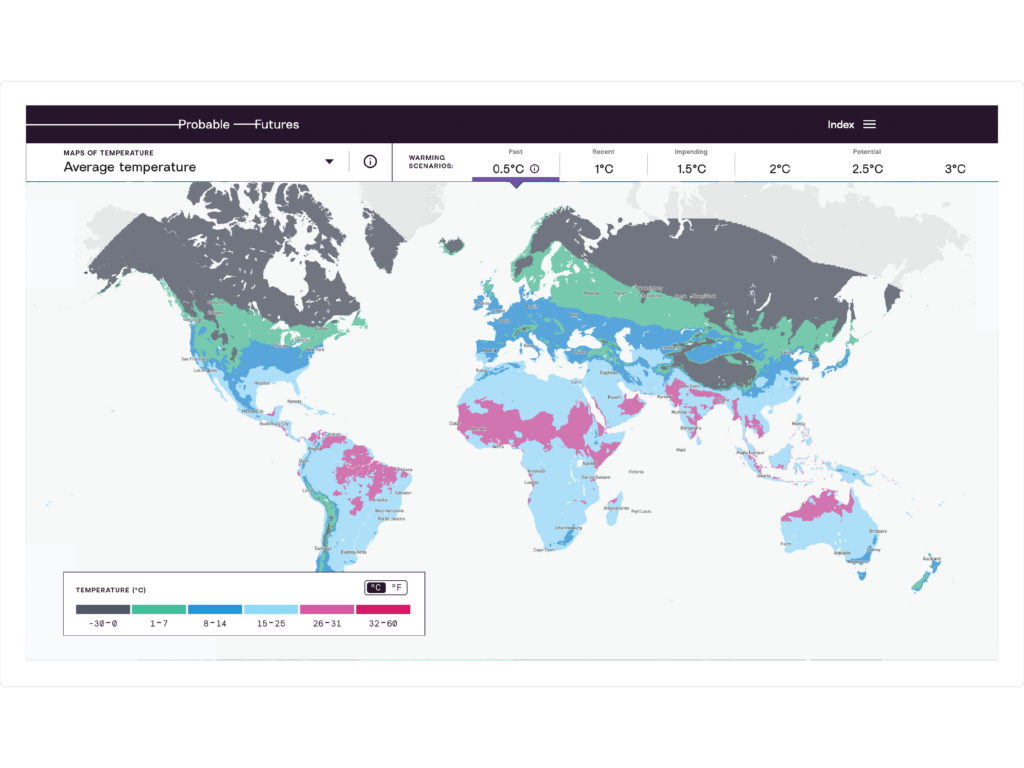
Revisiting Chimborazo
Here is a Probable Futures map showing the number of nights below freezing when the earth’s atmosphere was 0.5°C above the pre-industrial levels Humboldt experienced:
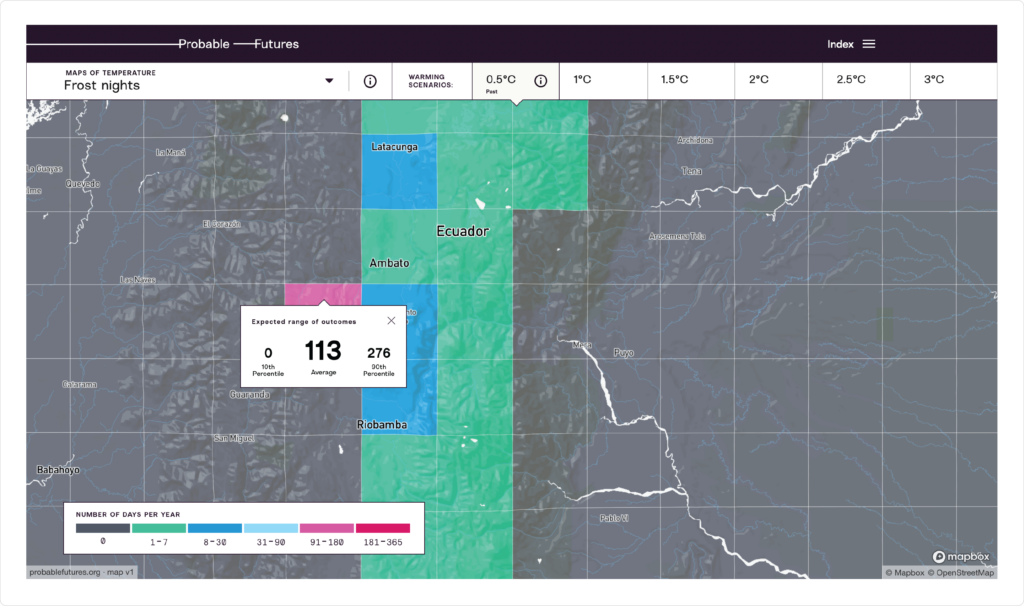
The gray locations averaged zero frost nights (it is the “Torrid Region” after all, right on the equator). The lone pink cell is exactly where Chimborazo is located. The volcano was covered in snow when Humboldt climbed it. The box shows that an average year in this high altitude would have about 113 nights below freezing, while in a warm year (10th percentile), there might be zero nights that dipped below freezing, and a cool year (90th percentile) 276 nights could be expected to have frost.
We are nearly at 1.5°C of warming already. How different is the climate around Chimborazo likely to be when we reach (or surpass) 1.5°C?
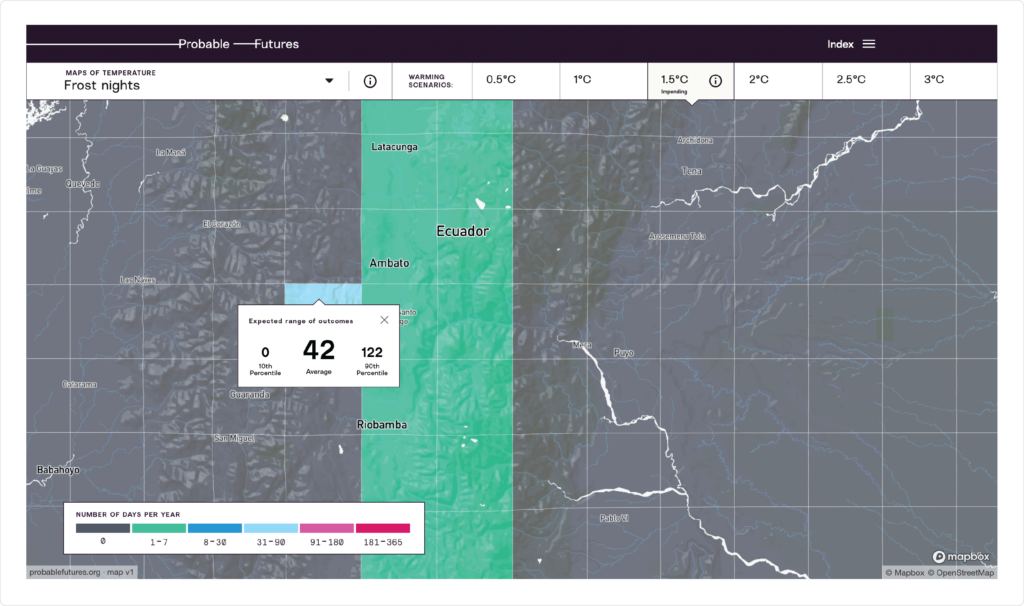
That one degree of warming drops the average from 113 nights below freezing to 42. A cold year (90th percentile) might have 122 freezing nights compared to the 300 or so that would have occurred during the nearly 12,000 years that preceded industrialization. It makes me wonder what is happening to all of those plants and animals on the mountain. If they are like their counterparts elsewhere, they are trying to move away from the equator and to higher altitudes to stay in their previous temperature range.
At the same time, humans are behaving in a way that the animals must find bizarre: Prosperous people are moving toward hotter, more fragile climates, and populations are growing fastest in the hottest places on Earth. When you explore the maps, you will be able to see what is likely if we reach 3°C and wonder what the limits of migration and adaptation might be.
For 150 years after he produced them, Humboldt’s maps remained accurate. They are no longer. The climate has already changed so much that where snow falls, where animals and plants thrive, and where the climate is temperate or torrid (and just how torrid it can be) has changed. How much further it warms will depend on how many people cross the divide between climate science and the rest of life.
If millions of people start incorporating climate concerns into their work with vigor, honesty, and a clear understanding of what is at stake and how we can avoid the unmanageable, we can get to zero emissions. Today’s children and their children can look forward to futures that, while challenging, will still have space for poetry, play, and the ability to pursue specific interests, including ones that have little to do with climate. If too few of us prioritize climate in our work now, the lives of future generations will be dominated by it.
Launching an initiative
Probable Futures is an effort to help all of us better understand, prepare for, and address what is coming as the climate continues to change due to human activity. Today we are releasing a global online utility that vividly communicates the consequences of climate warming. The plural Futures conveys the existence of a range of future outcomes, while Probable indicates that you should use this range as a guide: Some futures have zero probability, so we should stop acting as if they are possible; others are likely, and we must plan for them; and still others may have low probabilities but would be so catastrophic that ignoring them is a form of gross negligence.
I began this work partly inspired by Humboldt. To have anything like the influence that he had, let alone the impact that the world needs, I had to find help. I asked fellow generalist, Alison Smart, if she would be willing to use her skills and experience in arts, culture, and climate science to build a community and a process that would give us a chance to make something great. In order to be effective, whatever we produced would have to be beautiful and invoke feeling in the people we reached. Alison and I asked Tammy Dayton—whose design firm, Moth, had done great work for purposeful organizations—if she would be our Creative Director.
Over the past two years, Probable Futures has grown to include dozens of people working collaboratively. I am deeply grateful to all of them, both for giving so much to the initiative and for being such good companions. We each have our own experience of being changed by this work and realize that climate will be a part of our lives from now on. I am so proud of what we have built. It is better than anything I could have imagined. I hope you can feel their care and effort as you explore the Probable Futures site.
Our invitation
Humboldt’s good fortune allowed him to finance a grand adventure. We can make no claim to the experience of Probable Futures being as powerful as the chance to explore cities, deserts, mountains, tropical forests, and oceans, but few people can afford to explore, and flying to take in the world is perhaps the most damaging thing we can do. We hope that seeing the world through Probable Futures materials and maps and the stories we host will vivify our world and provide you with connectedness. We hope it helps educate, frame, motivate, train, and inform you, your organizations, your community, your family, and your decisions.
We all need to get comfortable with thinking about climate change. Few of us are going to become scientists, but if we want to keep an advanced, diverse society, each of us needs to become more of a generalist. Every journalist is going to be writing about climate change from one angle or another. Every business decision is going to have some element of climate in it. Whether in a small town or a presidential office, every government official will have to include climate change in their work. Outside of work, we need activists, protesters, and cultural leaders to send clear, urgent, informed messages that letting the future slip away is an avoidable tragedy. Even inside our homes and in our most intimate relationships, the vulnerability of our climate will affect what we do, eat, and hope for.
The way to address this challenge is to include as many people as we can. In the nine years since I first started exploring climate science, the trajectory of emissions has not deviated but still few people are working to address climate change. We need to change both of those facts immediately. We are hopeful that Probable Futures can help.
What we have learned along the way should be encouraging. For one thing, we can use the same science and tools both to teach children and to plan, manage, and act in a professional environment. Secondly, while we don’t know the future perfectly, these maps are very, very good.
It is time to stop referencing backward-looking maps for planning, risk, and regulation. The maps of 0.5°C and 1.0°C show us where we came from. 1.5°C and 2.0°C maps present scenarios for which we must prepare. Spending time exploring the full Probable Futures site will help you see how much risk lies before us. The maps go up to 2.5°C and 3°C—levels of warming we hope no one will experience, as they are unlikely to offer either the abundant nature or the poetry that Humboldt loved.
Over the past year, we have collaborated with a few organizations to see how they would use what we have been building. One executive in a bank said to us, “I originally thought maps were for teaching children and that we needed this information turned into a database or spreadsheet, but now I see that maps are tools.” Another, when asking us if his organization might use Probable Futures for training employees who were going to start working on climate said, “They are likely to be excited by a new dataset or a new opportunity. What they need to understand is that this is going to be the rest of their careers.”
The Probable Futures team also has much more work ahead. In a sense, the past two years of work were preparation. Over the coming months, we will be adding new features to the site as well as new volumes about Precipitation and Drought. We expect to collaborate with others to create formal training tools, and we are working on ways to integrate our maps and data into workplaces. We also plan to share and support creative endeavors.
We ‘re glad that you’re exploring the site. Take your time. Follow the various links, and dig into all of the maps. There is so much good stuff here. Let things sink in. Then use it. Show it to your kids, parents, colleagues, and friends. Tell stories with it. Download the illustrations and maps and stick them in a presentation or journal. Do things with it that we never thought of. Tell us how we could improve it.
As I said at the beginning of this letter, I started this work by myself. It is a great joy to now be part of a small community. We look forward to participating in a rapidly growing movement of people working to figure out how we can live better together. We know that there are things ahead that we haven’t imagined. We also know that we need you.
The challenge is enormous, and not every future is possible any longer, but where we go from here is still up to all of us.
Onward,

Spencer